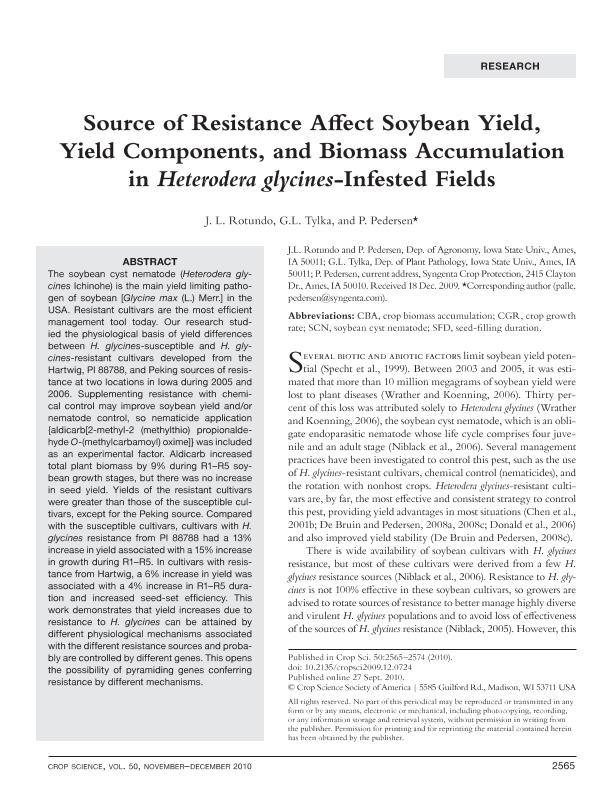Mostrar el registro sencillo del ítem
dc.contributor.author
Rotundo, José Luis

dc.contributor.author
Tylka, G.L.
dc.contributor.author
Pedersen, P.
dc.date.available
2020-02-14T15:18:30Z
dc.date.issued
2010-11
dc.identifier.citation
Rotundo, José Luis; Tylka, G.L.; Pedersen, P.; Source of resistance aff ect soybean yield, yield components, and biomass accumulation in Heterodera glycines-infested fields; Crop Science Society of America; Crop Science; 50; 6; 11-2010; 2565-2574
dc.identifier.issn
0011-183X
dc.identifier.uri
http://hdl.handle.net/11336/97550
dc.description.abstract
The soybean cyst nematode (Heterodera glycines Ichinohe) is the main yield limiting pathogen of soybean [Glycine max (L.) Merr.] in the USA. Resistant cultivars are the most efficient management tool today. Our research studied the physiological basis of yield differences between H. glycines-susceptible and H. glycines- resistant cultivars developed from the Hartwig, PI 88788, and Peking sources of resistance at two locations in Iowa during 2005 and 2006. Supplementing resistance with chemical control may improve soybean yield and/or nematode control, so nematicide application {aldicarb[2-methyl-2 (methylthio) propionaldehyde O-(methylcarbamoyl) oxime]} was included as an experimental factor. Aldicarb increased total plant biomass by 9% during R1-R5 soybean growth stages, but there was no increase in seed yield. Yields of the resistant cultivars were greater than those of the susceptible cultivars, except for the Peking source. Compared with the susceptible cultivars, cultivars with H. glycines resistance from PI 88788 had a 13% increase in yield associated with a 15% increase in growth during R1-R5. In cultivars with resistance from Hartwig, a 6% increase in yield was associated with a 4% increase in R1-R5 duration and increased seed-set efficiency. This work demonstrates that yield increases due to resistance to H. glycines can be attained by different physiological mechanisms associated with the different resistance sources and probably are controlled by different genes. This opens the possibility of pyramiding genes conferring resistance by different mechanisms. © Crop Science Society of America.
dc.format
application/pdf
dc.language.iso
eng
dc.publisher
Crop Science Society of America

dc.rights
info:eu-repo/semantics/openAccess
dc.rights.uri
https://creativecommons.org/licenses/by-nc-sa/2.5/ar/
dc.subject
Soybean
dc.subject
Plant Disease
dc.subject
Crop Growth
dc.subject
Crop Development
dc.subject.classification
Agricultura

dc.subject.classification
Agricultura, Silvicultura y Pesca

dc.subject.classification
CIENCIAS AGRÍCOLAS

dc.title
Source of resistance aff ect soybean yield, yield components, and biomass accumulation in Heterodera glycines-infested fields
dc.type
info:eu-repo/semantics/article
dc.type
info:ar-repo/semantics/artículo
dc.type
info:eu-repo/semantics/publishedVersion
dc.date.updated
2019-03-08T20:30:29Z
dc.journal.volume
50
dc.journal.number
6
dc.journal.pagination
2565-2574
dc.journal.pais
Estados Unidos

dc.journal.ciudad
Baltimore
dc.description.fil
Fil: Rotundo, José Luis. University of Iowa; Estados Unidos. Consejo Nacional de Investigaciones Científicas y Técnicas. Oficina de Coordinación Administrativa Parque Centenario. Instituto de Investigaciones Fisiológicas y Ecológicas Vinculadas a la Agricultura. Universidad de Buenos Aires. Facultad de Agronomía. Instituto de Investigaciones Fisiológicas y Ecológicas Vinculadas a la Agricultura; Argentina
dc.description.fil
Fil: Tylka, G.L.. Syngenta Crop Protection; Estados Unidos
dc.description.fil
Fil: Pedersen, P.. University of Iowa; Estados Unidos
dc.journal.title
Crop Science

dc.relation.alternativeid
info:eu-repo/semantics/altIdentifier/url/https://acsess.onlinelibrary.wiley.com/doi/abs/10.2135/cropsci2009.12.0724
dc.relation.alternativeid
info:eu-repo/semantics/altIdentifier/doi/http://dx.doi.org/10.2135/cropsci2009.12.0724
Archivos asociados
